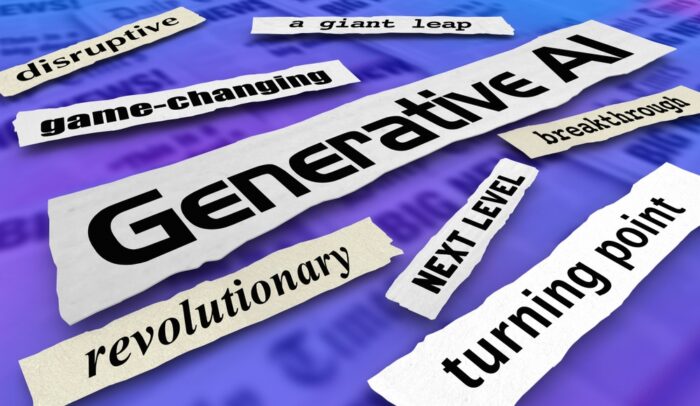If you’ve read any tech media this week (or month … or year…) you’ve undoubtedly seen the uptick of generative AI PR coverage and the broader discussions of just what an AI-adopted future world will look like. It’s no longer an “if” but a “when” for AI – forcing businesses and organizations of all kinds to figure out how to integrate it and stay ahead of innovation. Below is a snapshot of some of the media coverage of generative AI we found most interesting this week.
Apple Intelligence Will Infuse the iPhone With Generative AI – WIRED
Craig Federighi, senior vice president of software engineering at Apple, said the company’s new AI strategy will focus on privacy and security. In addition to stressing privacy-friendly, on-device AI use cases, Federighi introduced what the company calls Private Cloud Compute, a technology that claims to protect data even for more intensive AI tasks that necessitate the cloud. “Your data is never stored or made accessible to Apple,” he said.
Apple showed off Apple Intelligence across numerous apps. A feature called Writing Tools, available system wide, can clean up your text for grammar and readability, and adjust the tone to be more friendly or more professional. Apple’s so-called Image Playground will let you create images across Apple like in Messages and Notes, including AI-generated images of contacts in three different styles: sketch, illustration, and animation. You’ll also be able to create custom emoji with generative AI, a feature Apple calls Genmoji. And an AI refresh to Siri will make the assistant better able to handle complex spoken commands and better able to search for information even if a command is ambiguous.
Amazon Leans Into Generative AI to Manage Its Finances – The Wall Street Journal
Its finance teams are turning to generative AI in areas such as fraud detection, contract review, financial forecasting, personal productivity, interpretation of rules and regulations, and tax-related work, moves in part aimed at reducing costs, boosting efficiencies and increasing accuracy, company executives said. These use cases are in a mix of experimentation and implementation stages.
“While experimentation and getting to know the technology are things that we really want to speed up, actually deploying this into production and making sure that we are in a well-controlled situation is very, very important for us,” said Dave George, vice president of finance technology at Amazon.
The Vital Difference Between Machine Learning And Generative AI – Forbes
While machine learning and generative AI are both subsets of artificial intelligence, their primary distinction lies in their purpose and output. Generative AI PR has dominated the headlines, but it’s important to know the difference between the two technologies.
- Purpose: Machine learning focuses on understanding and predicting based on existing data. Generative AI, however, is geared towards creating new data that mimics human creations.
- Output: Machine learning outputs decisions or predictions. Generative AI produces new content, such as text, images, or music.
- Applications: Machine learning is used for tasks like recommendation systems, predictive analytics, and diagnostic tools. Generative AI is employed in creative domains, deepfakes, and advanced simulations.
Boards Need to Weigh Risk and Value With Generative AI Deployment – Bloomberg Law
Boards with a deep understanding of an organization’s purpose and intended value of generative AI can help propel a human-centric approach. Diverse perspectives and lived experiences are important—a diverse group of business leaders (and board members) are best-positioned to consider generative AI’s range of outcomes and societal impact.
By focusing the vision for generative AI on human trust and net benefits for society, boards can help their organizations maximize business benefit, mitigate enterprise and societal risks, and promote generative AI value that is equitable and sustainable.
MIT Researchers Introduce Generative AI for Databases – MIT News
GenSQL, a generative AI system for databases, could help users make predictions, detect anomalies, guess missing values, fix errors, or generate synthetic data with just a few keystrokes. When the researchers compared GenSQL to popular, AI-based approaches for data analysis, they found that it was not only faster but also produced more accurate results. Importantly, the probabilistic models used by GenSQL are explainable, so users can read and edit them.
A GenSQL user uploads their data and probabilistic model, which the system automatically integrates. Then, she can run queries on data that also get input from the probabilistic model running behind the scenes. This not only enables more complex queries but can also provide more accurate answers.
How Generative AI is Shaping Drug Discovery – Healthcare Brew
Drug companies are increasingly interested in how AI could potentially help speed up the drug discovery process, which can take around a decade and an average of $2.7 billion, the Financial Times reported. In Q1 2024, the global pharmaceutical industry saw a 45% increase in how often AI was mentioned in company filings from Q4 2023, according to Pharmaceutical Technology.
Her team used the AI tech on Generate’s platform while developing a drug intended to prevent Covid-19 from spreading in the body. According to Snyder, AI was able to create a drug that binds to an area of the virus that researchers hadn’t been able to identify previously. While many drugs can typically take three to five years to move from idea to first dose, she told Healthcare Brew, AI condensed the time to 1.5 years.
The US Intelligence Community is Embracing Generative AI – Nextgov/FCW
The normally secretive U.S. intelligence community is as enthralled with generative artificial intelligence as the rest of the world, and perhaps growing bolder in discussing publicly how they’re using the nascent technology to improve intelligence operations.
Raman said U.S. intelligence analysts currently use generative AI in classified settings for search and discovery assistance, writing assistance, ideation, brainstorming and helping generate counter arguments. These novel uses of generative AI build on existing capabilities within intelligence agencies that date back more than a decade, including human language translation and transcription and data processing.
Despite Adoption Hurdles, Healthcare is All-in on Generative AI – CIO
GenAI budgets are growing exponentially. Adoption of GenAI varies significantly across roles and company sizes. Technical leaders are at the forefront, demonstrating higher adoption rates and driving budget increases. While 34% of all respondents reported a 10-50% budget increase for GenAI, 22% witnessed a 50-100% rise. Among technical leaders, nearly one-fifth reported a staggering 300% budget growth, underscoring their advocacy and investment in GenAI.
Task-specific language models reign supreme. The healthcare sector’s unique needs are driving a preference for custom-built, task-specific language models. Healthcare-specific small models are utilized by 36% of respondents, reflecting a clear trend towards targeted solutions over general-purpose large language models (LLMs). This is not surprising given the high stakes of real patient outcomes, the sensitive nature of healthcare data, and a host of regulatory standards to adhere to.
Do you have a generative AI project or technology that requires media exposure?
FischTank PR is a top B2B and innovation tech PR firm spanning Generative AI, AI/ML, cyber security, enterprise tech, fintech, healthcare tech, and much more. If you’re interested in discussing a generative AI PR program for your brand, reach out to us at [email protected].
***Generative AI PR news roundup guest post from FischTank PR interns Baylee Matthews and Uju Ike***




